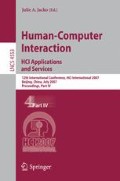Abstract
Since medical devices are often linked to the alarmingly high rate of medical accidents, it is speculated that newer advanced user interface related technologies might mitigate some accidents. This paper describes some positive as well as negative consequences of incorporating advanced technologies with particular emphasis on technologies that directly impact the design and usability of medical device user interfaces. Notably, some technologies open opportunities to allow users more control to manipulate devices and to more effectively be alerted to usage situations with high patient safety risk. On the other hand, some technologies offer more complexity for user interface features and therefore may increase risk levels. A sample of these advanced technologies is examined for their impact on design heuristics. The paper also examines current formal risk evaluation, analysis and control methodologies used in design. These risk management methods are applied to a variety of advanced user interface technologies used in various categories of medical devices. The advanced technologies examined for risk control advantages as well as disadvantages include: (1) improved displays, e.g. large color touchscreens; (2) improved sounds, e.g. speech synthesizers for talking AED’s and talking MRI systems; (3) intelligent software, e.g. drug libraries with hard and soft limits for programming devices that deliver medications; (4) advanced drug injection systems, e.g. high pressure needle-free delivery, electronic drug delivery skin patches; (5) network connectivity, e.g. internet-aware devices that warn against dangerous drug/device interactions and medication management systems that reduce medication dispensing errors; (6) robotic innovations, e.g. remote surgery systems and automatic diagnostic assay preparation systems; (7) laparoscopic advancements, e.g. 3D video cameras; innovative mechanical devices, e.g. novel metal clip artery closure systems and beating heart suturing systems; (8) RFID tracking and monitoring systems, e.g. RFID embedded in surgical sponges to reduce accidental miscounts during surgery and (9) speech controlled medical devices, e.g. operating room table adjustments and laparoscopic video camera adjustments.
Access this chapter
Tax calculation will be finalised at checkout
Purchases are for personal use only
Preview
Unable to display preview. Download preview PDF.
References
FDA: Medical device use safety- incorporating human factors engineering into risk management, FDA 1497 (July 18, 2000)
IEC: IEC 62366:2007 Medical devices - Application of usability engineering to medical devices (2007)
ISO: ISO 14971:2000 Medical devices – application of risk management to medical devices (2000)
Israelski, E.W., Muto, W.H.: Human factors risk management as a way to improve medical device safety: a case study of the therac-25 radiation therapy system. Joint Commission Journal on Quality and Safety 30(12), 689–695 (2004)
Zhang, J., Johnson, T.R., Patel, V., Paige, D., Kubose, T.: Using Usability Heuristics to evaluate patient safety of medical devices. Journal of Biomedical Informatics 36, 23–30 (2003)
Author information
Authors and Affiliations
Editor information
Rights and permissions
Copyright information
© 2007 Springer-Verlag Berlin Heidelberg
About this paper
Cite this paper
Muto, W.H., Israelski, E.W. (2007). How New Technologies Can Help Create Better UI’s for Medical Devices. In: Jacko, J.A. (eds) Human-Computer Interaction. HCI Applications and Services. HCI 2007. Lecture Notes in Computer Science, vol 4553. Springer, Berlin, Heidelberg. https://doi.org/10.1007/978-3-540-73111-5_57
Download citation
DOI: https://doi.org/10.1007/978-3-540-73111-5_57
Publisher Name: Springer, Berlin, Heidelberg
Print ISBN: 978-3-540-73109-2
Online ISBN: 978-3-540-73111-5
eBook Packages: Computer ScienceComputer Science (R0)

